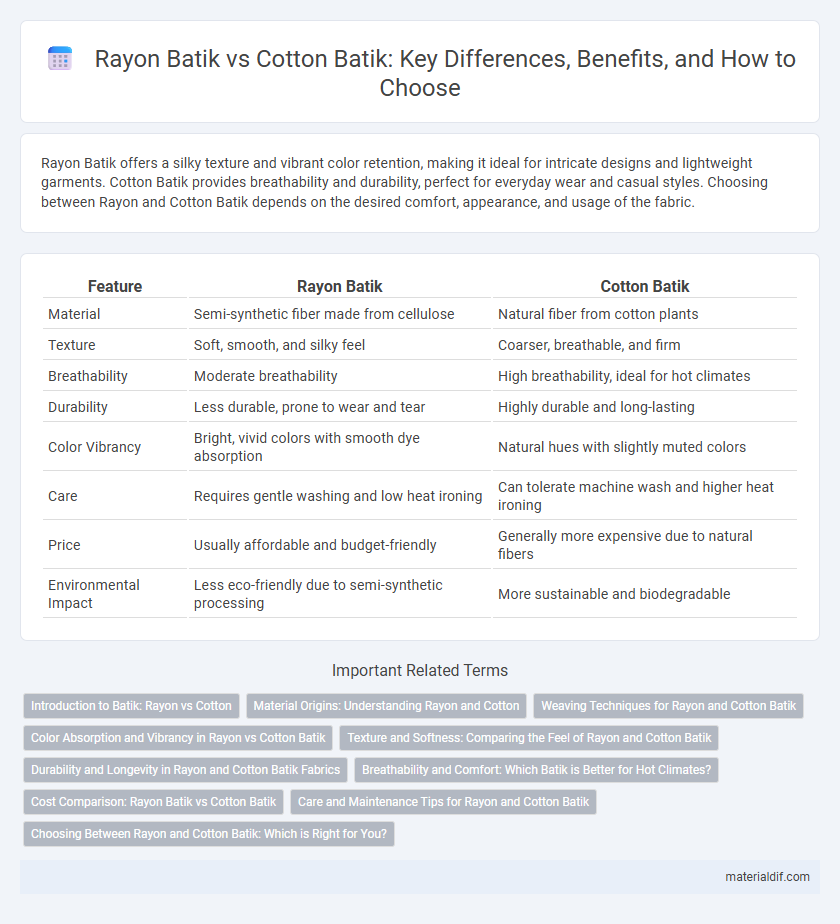Rayon Batik offers a silky texture and vibrant color retention, making it ideal for intricate designs and lightweight garments. Cotton Batik provides breathability and durability, perfect for everyday wear and casual styles. Choosing between Rayon and Cotton Batik depends on the desired comfort, appearance, and usage of the fabric.
Table of Comparison
| Feature | Rayon Batik | Cotton Batik |
|---|---|---|
| Material | Semi-synthetic fiber made from cellulose | Natural fiber from cotton plants |
| Texture | Soft, smooth, and silky feel | Coarser, breathable, and firm |
| Breathability | Moderate breathability | High breathability, ideal for hot climates |
| Durability | Less durable, prone to wear and tear | Highly durable and long-lasting |
| Color Vibrancy | Bright, vivid colors with smooth dye absorption | Natural hues with slightly muted colors |
| Care | Requires gentle washing and low heat ironing | Can tolerate machine wash and higher heat ironing |
| Price | Usually affordable and budget-friendly | Generally more expensive due to natural fibers |
| Environmental Impact | Less eco-friendly due to semi-synthetic processing | More sustainable and biodegradable |
Introduction to Batik: Rayon vs Cotton
Batik is a traditional fabric art form featuring intricate wax-resist dyeing techniques. Rayon batik is prized for its smooth texture, vibrant colors, and affordability, while cotton batik is valued for its breathability, natural fibers, and durability. Choosing between rayon and cotton batik depends on preferences for comfort, fabric feel, and maintenance requirements.
Material Origins: Understanding Rayon and Cotton
Rayon is a semi-synthetic fiber derived from regenerated cellulose, typically sourced from wood pulp, while cotton is a natural fiber harvested directly from cotton plants. Rayon's production involves chemical processes that transform plant-based cellulose into smooth, breathable fabric, offering a silk-like feel with high absorbency. Cotton Batik, on the other hand, features natural fibers known for durability, moisture-wicking properties, and a more textured surface compared to the soft, fluid drape characteristic of Rayon Batik.
Weaving Techniques for Rayon and Cotton Batik
Rayon Batik utilizes a synthetic fiber that allows for smoother dye absorption and intricate detail in the wax-resist technique, resulting in vibrant patterns with a silky texture. Cotton Batik relies on natural cotton fibers, which produce a more matte finish and a slightly coarser texture due to the natural weave, often requiring longer drying times and more careful wax application. The weaving technique for cotton emphasizes durability and breathability, while rayon's technique focuses on achieving luster and fluidity in the fabric.
Color Absorption and Vibrancy in Rayon vs Cotton Batik
Rayon Batik exhibits superior color absorption due to its semi-synthetic fiber structure, allowing dyes to penetrate more deeply than in natural cotton fibers. This results in more vibrant and long-lasting colors compared to cotton batik, which tends to display softer, more muted hues over time as cotton fibers absorb dyes superficially. The enhanced vibrancy of rayon batik makes it a preferred choice for designs requiring bold and striking patterns.
Texture and Softness: Comparing the Feel of Rayon and Cotton Batik
Rayon Batik offers a smooth, silky texture that feels lightweight and cool against the skin, enhancing comfort in warm climates. Cotton Batik, known for its natural fibers, provides a crisp, breathable fabric with a slightly coarse texture that softens with washing. The softness of rayon makes it preferable for delicate garments, while cotton's durability suits everyday wear.
Durability and Longevity in Rayon and Cotton Batik Fabrics
Rayon Batik exhibits moderate durability but tends to wear out faster than Cotton Batik due to its semi-synthetic nature, which makes it prone to pilling and weakening with frequent washing. Cotton Batik stands out for superior longevity, maintaining vibrant colors and fabric strength over time due to its natural fiber composition and resilience. For long-term use and preservation of intricate Batik patterns, Cotton Batik offers a more durable and lasting fabric option compared to Rayon Batik.
Breathability and Comfort: Which Batik is Better for Hot Climates?
Rayon Batik offers superior breathability compared to Cotton Batik due to its semi-synthetic fiber structure that allows better air circulation and moisture absorption. Cotton Batik provides natural comfort and softness but tends to retain heat and moisture, making it less ideal for prolonged wear in hot climates. For optimal comfort in high temperatures, Rayon Batik is often preferred for its lightweight, breathable, and moisture-wicking properties.
Cost Comparison: Rayon Batik vs Cotton Batik
Rayon Batik typically has a lower production cost compared to Cotton Batik, making it more affordable in retail pricing. The synthetic nature of rayon fibers allows for quicker manufacturing processes and lower raw material expenses, while cotton requires more time-consuming cultivation and harvesting. This cost disparity makes Rayon Batik a popular choice for budget-conscious consumers without significantly compromising on aesthetic appeal.
Care and Maintenance Tips for Rayon and Cotton Batik
Rayon Batik requires gentle hand washing in cold water with mild detergent to prevent fabric weakening and color fading, while avoiding wringing and direct sunlight drying. Cotton Batik can endure machine washing on a gentle cycle but benefits from air drying to maintain fabric integrity and vibrant colors. Both fabrics should be ironed on a low to medium heat setting, preferably inside out, to preserve the intricate batik designs and prevent damage.
Choosing Between Rayon and Cotton Batik: Which is Right for You?
Rayon Batik offers a smooth, silky texture with vibrant color absorption, ideal for lightweight and breathable clothing, while Cotton Batik provides durability, natural comfort, and better moisture absorption, making it suitable for everyday wear. Choosing between Rayon and Cotton Batik depends on preferences for fabric feel, climate considerations, and garment usage, as Rayon feels cooler and more luxurious but requires delicate care, whereas Cotton is easier to maintain and more resilient. Understanding these fabric properties ensures you select the right Batik material tailored to your style and functional needs.
Rayon Batik vs Cotton Batik Infographic

 materialdif.com
materialdif.com